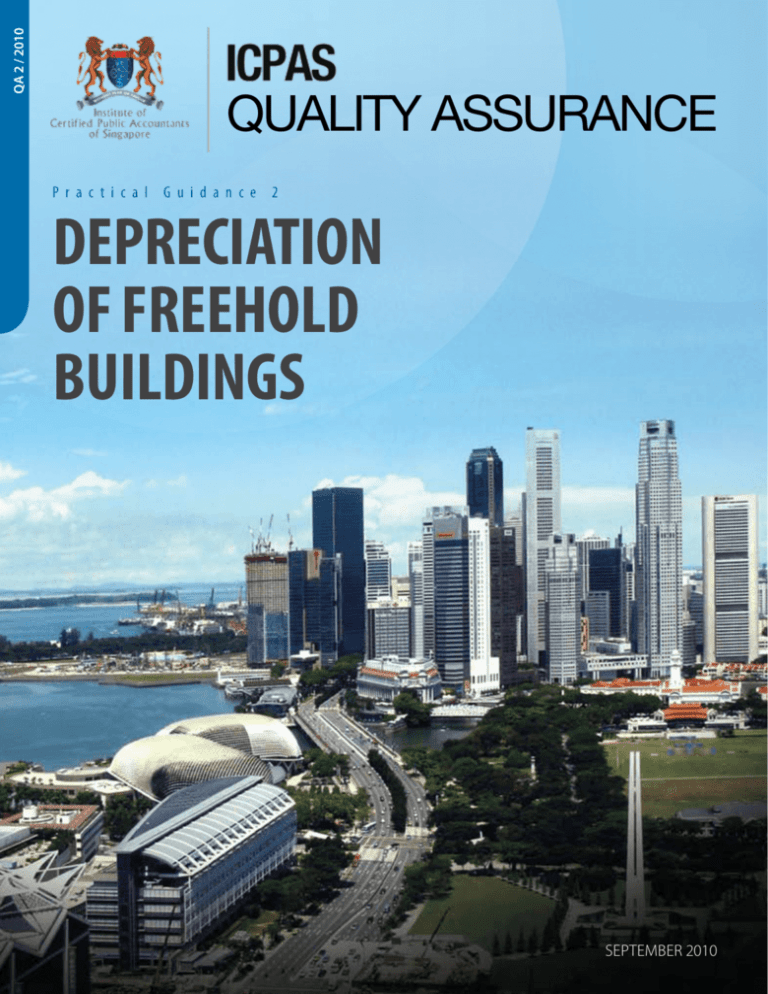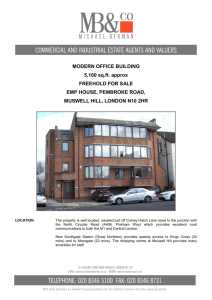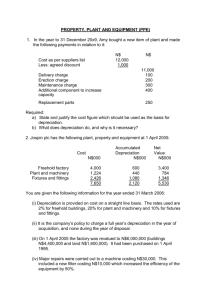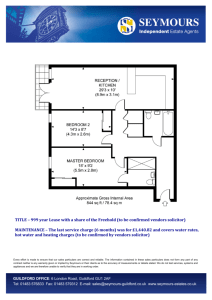
QA 2 / 2010
QUALITY ASSURANCE
Pra c tic a l Gui da nce 2
Depreciation
of Freehold
Buildings
September 2010
2
Introduction
ICPAS Quality Assurance 2010 Practical Guidance
1. The carrying amount of freehold buildings is usually a
material balance on the balance sheet and significant
to the financial statements. The common audit
assertions related to freehold buildings are existence,
rights & obligations and valuation.
6. Singapore Standard on Auditing (SSA) 540 “Audit
of Accounting Estimates”, paragraph 8 states that
“The auditor should design and perform further
audit procedures to obtain sufficient appropriate
audit evidence as to whether the entity’s accounting
estimates are reasonable in the circumstances and,
when required, appropriately disclosed”.
2. Some common practical difficulties in determining
the depreciation charge of freehold buildings include:
(a) Inability to determine the useful life of freehold
buildings given the nature of the tenure; and
(b) Inability to determine the cost of freehold
buildings in situations where land and buildings
are acquired together and classified as a single
class of property, plant and equipment.
7. The auditors can do so by critically assessing
the factors that management has considered in
determining the estimate which could include review
of current market practice or making references to
similar freehold properties in the same vicinity etc.
As with all judgemental matters, auditors should
assess the reasonableness of the useful life of freehold
properties with an attitude of professional scepticism.
Guiding Principle
Determining the cost of freehold
buildings
3. Financial Reporting Standard (FRS) 16 “Property,
Plant and Equipment” states that “buildings have
a limited useful life and therefore are depreciable
assets”. It also establishes that in situations where land
and buildings are acquired together, they are to be
accounted for separately (paragraph 58). Essentially,
notwithstanding depreciation is not required for
freehold land, freehold buildings will need to be
depreciated. FRS 16 does not distinguish between
freehold or leasehold buildings. All buildings will need
to be depreciated regardless of tenure.
4. FRS 16, however, does not provide guidance in the
determination of useful life of freehold buildings nor
in the determination of cost of freehold buildings
in situations where land and buildings are acquired
together.
8. The other factor to consider is the depreciable
amount of the freehold building which is usually
determined after deducting its residual value. It is
important to note that FRS 16, paragraph 54 states
that “The residual value of an asset may increase to an
amount equal to or greater than the asset’s carrying
amount. If it does, the asset’s depreciation charge is
zero unless and until its residual value subsequently
decreases to an amount below the asset’s carrying
amount”.
9. In situations where land and buildings are acquired
together, the cost of the freehold buildings will need
to be segregated from the cost of the freehold land
as mentioned in paragraph 3. This information could
be obtainable from the sale and purchase agreement
if the cost of land and building were separately
determined at the time of purchase.
Practical Application
Determining the useful lives of
freehold buildings
5. To apply a depreciation policy on freehold buildings,
the fundamental measure that needs to be
determined is the useful life of the buildings. The
estimation of the useful life of the asset is a matter
of judgement based on the experience of the entity
with similar assets (FRS 16, paragraph 57).
10. If no separate cost information is available,
auditors will have to consider alternatives such as
requesting management to engage an independent
professional valuer to estimate the cost of the
building, separate from the land cost at the point
of purchase. When using the work of an expert
like a professional valuer, the auditors would need
to consider factors such as competence and
objectivity of the expert, scope of the expert’s work
in evaluating the work of the expert, in accordance
with SSA 620 “Using the Work of an Expert”.
3
Quantifying the financial impact
Example: Illustrating the quantification of impact retrospectively for depreciation of freehold buildings
Freehold building acquired in 1990 (no depreciation has been provided
since purchase)
Cost Of Freehold Building Determined (S$)
Useful Life Determined (Years)
Annual Depreciation (S$)
No Of Years From 1990 To 2007 (Years)
Depreciation From 1990 To 2007 (S$)
Depreciation For 2008 (S$)
1,000,000
[A]
50
[B]
20,000
17
340,000
[C] = [A] / [B]
[D]
[E] = [C] X [D]
20,000
Quantifying Impact Of Prior Years
Retrospectively
Dr/(Cr)
S$
Accumulated Depreciation
(340,000)
Retained Earnings
340,000
(to adjust retrospectively the depreciation from 1990 to 2007)
(i.e. adjust against retained earnings in the statement of changes in equity as an error)
Quantifing Current Year Impact
Depreciation Expense
20,000
Accumulated Depreciation
(20,000)
(to adjust the depreciation for current year 2008)
12. When the useful lives and costs of the freehold
buildings could not be reasonably determined and
no depreciation has been provided in the financial
statements, this would not comply with FRS 16.
Auditors will have to quantify, where practicable,
the financial impact of the non-compliance on
the financial statements and assess if there is
any material misstatement. The auditors should
also consider amongst others, the impact on
the property, plant and equipment balance, net
assets, total assets, validity of the going concern
assumption, retained earnings and current year
income statement.
13. Furthermore, arising from the above noncompliance, the auditor will have to consider if the
audit opinion needs to be modified in accordance
with SSA 701 “Modifications to the Independent
Auditor’s Report”. An unqualified audit opinion may
not be appropriate and the auditor has to consider
if a qualified (except for) opinion on limitation of
scope, a disclaimer of opinion or an adverse opinion
is more appropriate in the context of the situation.
ICPAS Quality Assurance 2010 Practical Guidance
11. The following example illustrates the accounting for the depreciation of freehold buildings in a scenario where
the cost of freehold building and its useful life is determinable but no depreciation has been provided since the
date of acquisition:
INSTITUTE OF CERTIFIED PUBLIC ACCOUNTANTS OF SINGAPORE
20 Aljunied Road
#06-02 CPA House
Singapore 389805
Tel (65) 6749 8060
Fax (65) 6749 8061
Email: cpasingapore@icpas.org.sg
w w w. i c p a s . o rg . s g
Practical
Guidance
About ICPAS Quality Assurance
ICPAS Quality Assurance strives to encourage conformity with professional accounting standards and practices to enhance
the work quality of its members. ICPAS Quality Assurance identifies common areas of consideration and aims to offer value
adding practice development publications and organise relevant events to support the Institute in its efforts to uphold the
standard of the accounting profession.
Please send your comments and suggestions to qualityassurance@icpas.org.sg.
Disclaimer Statement
This document contains general information only and Institute of Certified Public Accountants of Singapore (ICPAS) is
not, by means of this document, rendering any professional advice or services. This document is not a substitute for such
professional advice or services, nor should it be used as a basis for any decision or action that may affect your business.
Before making any decision or taking any action that may affect your business, you should consult a professional advisor.
Whilst every care has been taken in compiling this document, ICPAS makes no representations or warranty (expressed or
implied) about the accuracy, suitability, reliability or completeness of the information for any purpose. ICPAS, its employees
or agents accept no liability to any party for any loss, damage or costs howsoever arising, whether directly or indirectly from
any action or decision taken (or not taken) as a result of any person relying on or otherwise using this document or arising
from any omission from it.
Copyright
Copyright © September 2010 by ICPAS. All rights reserved. No part of this publication may be reproduced, stored in a
retrieval system, or transmitted in any form by any means, electronic, mechanical, photocopying, recording or otherwise,
without prior written permission from ICPAS.








